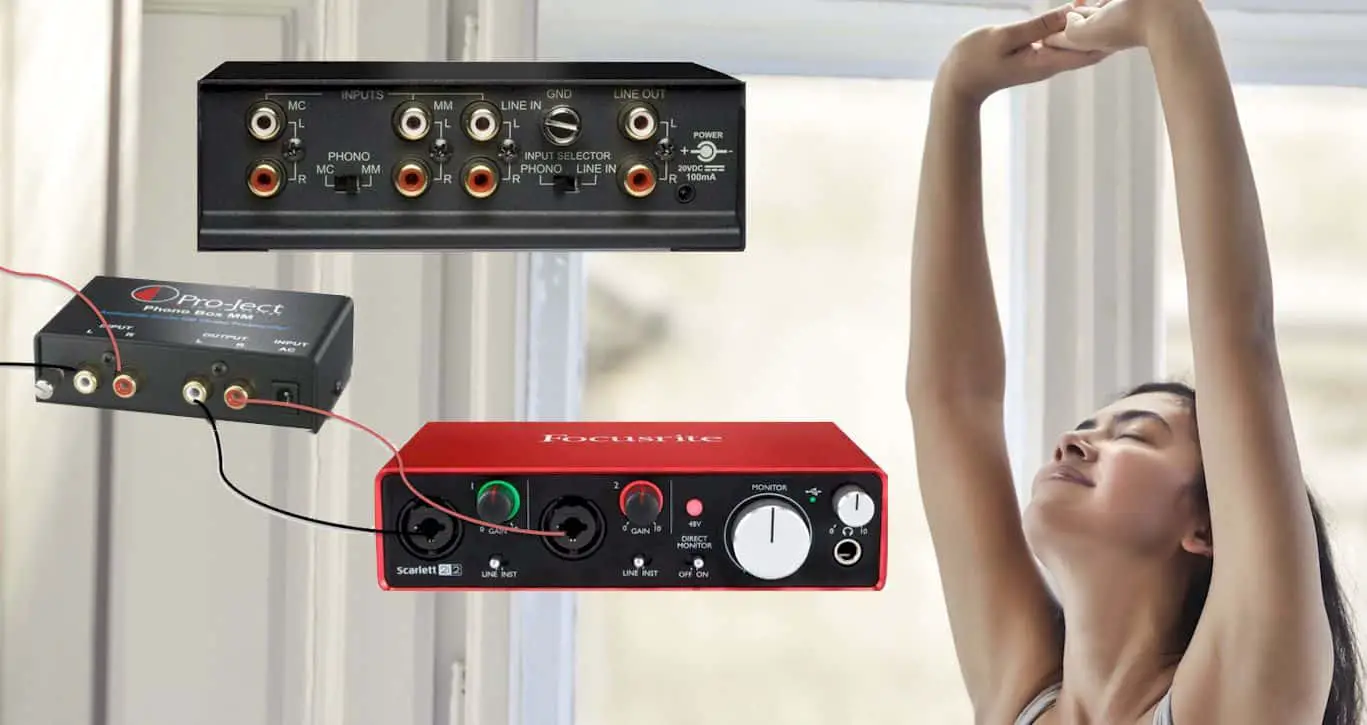Part of getting the best listening experience with your turntable is getting your setup phase right. Once the setup is right, you’ll enjoy your turntable. If not, you’d probably assume a function is bad and needs repairs. Or, in the case of a new turntable, request a refund. However, the fault could be that you plugged the phono signal in the input meat for the line signal. Don’t worry; it’s a common mistake that plagues both beginners and experienced users.
But to prevent the mix-up from reoccurring, we’ll address the phono vs. line issue. We’ll also identify possible problems that might spring from mixing up the two signals. Without further ado, let’s dig in already.
Contents
PHONO signal
The phono signal is usually very low. But before we get down to the Phono signal, let’s give you a back story first. We have to talk about phono inputs before we dive into what phono signal means. So, what is phono input is? For starters, phono input is short for phonograph input and is merely a receiver. Think about it as an amplifier or a socket that helps you make sense of your analog turntable.
In other words, it is that input spaces that you connect your analog turntable to. You’ll find the phono input on the preamp. It sits pretty on the rear panel on your preamp or amplifier, or mixer. They're also used to be a phono input on the first radio sets that were invented. Now, you might not come across phono inputs on radio sets.
More recently, you will also find phono inputs on audio components that are complicating. In other words, an amateur would probably not be able to master complicated audio components with phono inputs fully. As long as a turntable or phonograph is attached to a radio set, amplifier, preamp, it has a phono input. It then takes the signal that the attached turntable throws at it.
After receiving the signal from the analog turntable, the phono input proceeds to boost the signal. It does this for a major reason; to improve phonograph recordings. The truth is, phonograph recordings have certain imperfections. For instance, it is often clouded with background noises. You’d hear the pops, etc., these background noises are not ideal. Hence the need for a phono input with the ability to provide RIAA equalization.
The presence of the phono input for proper utilization drastically improves the phonograph recordings as you’d no longer hear the background noise. Basically, a phono input ensures that you hear the content of your vinyl record clearly and loudly using the built-in preamp.
So, the phono signal is the phono output. That is the strength level of sound or result you get during playback. Usually, the phono signal is low. It usually ranges from 0.005 voltage and above. Typically, turntables without built-in preamps give off phono signals. When next you set up your turntable ad, you notice the sound it gives is quite off; you might be outputting a phono signal as it operates on a low voltage.
Furthermore, two voltage types accompany a phono signal. These voltage types are heavily dependent on the cartridge type that’s on your turntable. If you have a moving coil, the phono signal voltage type would be weaker than when a moving magnet is mounted on your turntable.
LINE signal
Like the phono signal, the line signal also refers to the strength level of an audio sound. But it doesn’t end at being just the strength of an audio level. Specifically, it refers to the audio strength required to transmit the analog sound created from one audio component to another.
Some of these audio components that are major senders and receivers in the Line game include your television sets, DVD and CD players, mixing consoles, etc. Line levels are usually specified audio strength. For instance, in general, line outputs are mostly a standardized 0.316 volt when it comes to turntables and audio components.
There are quite a few other audio signals that exist. For instance, stronger audio signals are used with speakers, and weaker signals are common with microphones. While the signals from microphones and speakers are classified as weak and strong signals, respectively, the line signals from DVD, CD, turntable with line-level output, etc., are classified as strong and weak signals.
Quite a lot of audio components make use of the line signal. Your tape recorder, for instance, is another audio component that uses a line signal. In fact, almost all audio components use the standardized line output.
As earlier stated, the only component that works without the help of the line output is the turntables that have no built-in preamps. If you attempt to connect a Line signal to a Phono signal, you won’t like the result you’ll get. You’ll get no audio at all.
With so many inputs space, it is okay to be confused about line and phono signals. But we would clear up the confusion for you as you dig deeper into this article.
PHONO VS LINE
Now that you know what both signals generally are let’s spot out the features that distinguish them. Here are the differences between phono and line signals.
Signal classification:
If you’ve been following the detailed explanation of both signal levels, you’d realize right off the bat that line-level signal is classified as a medium signal, and phono signals fall in the weak signal category. Take their voltage output level, for instance. Line signal has a standard voltage output level which is 0.316 volt. This output level puts it in the class in between strong and weak signals. It is what you’ll get from a Sony DVD player or a CD player from any brand. These home audio components operate with the line signal. That’s why they considerably loud enough the fill the air in the living room. The sound from a DVD player without connecting it to a speaker might not be heard from the front door, but it is relatively loud.
On the other hand, the phono signal falls under the weaker signal classification. It is similar to the signal that microphones operate on. Generally, turntables with phono output do not have internal preamps to announce the music in your vinyl record to whoever is close by.
One has a Standard voltage; the other does not:
You should be able to guess this too. The line signal has a fixed output voltage standard. The voltage standard is 0.316 volts, as earlier mentioned. The line signal output voltage is what audio components like a tape recorder, PC’s and Laptops, turntable with preamps, Aux, and other similar audio components operate. Meanwhile, a phono signal isn’t fixed. The reason is, the output voltage of a phono signal varies due to the types of cartridges that exist. Although generally weaker, a phono level would produce a 0.0002 Volt when a moving coil cartridge is on your turntable. But with a moving magnet cartridge, you can get a phono signal voltage output of 0.007 Volt. You can have a phono signal voltage output that is higher than the voltage you get from a moving magnet. By simply mounting a mainstream cartridge on your turntable, you can get a 5mV phono signal.
RIAA Equalization:
Another difference between phono and line is RIAA equalization. The bass is boosted with the line signal, and the treble is reduced, thanks to the RIAA equalization. In the end, what you’ll have accompanied the line signal is a flat frequency response. But the phono signal has to be corrected by the equalizer. The reason is, the phono signal produces increased treble and reduced/ zero bass at all. But the RIAA equalizer steps in and corrects the irregularities with the phono signal.
FAQ
- Does Phono sound better than a line?
The answer is an easy no! phono signal does not sound better than a line signal. The reason is, the phono signal output voltage is lower compared to a line signal output voltage. Although the phono signal output voltage depends on the type of cartridge on your turntable, it still does increase the possible phono signals that could be generated higher than that of the lie signal voltage output.
- Do I need a preamp if my receiver has a phono input?
The answer is No! the only time you would need a phono preamp is if your receiver lacks a phono input. However, most receivers are built with phono inputs. Except if your receiver is not a serious receiver, it might not come with a phono input. All-in-one stereos might also not come with phono inputs.
- Should my turntable be on phono or line?
Generally, all turntables require preamps, built-in or not, to produce any sound at all. With a preamp, your line output would amplify your sound very well. However, phono outputs might not amplify your sound if the preamp is built-in. So, if your turntable comes with a built-in preamp, then you are better off using the line output. If not, stick to the phono output.
Bottom line
Now that you know the difference between line signal and phono signal, you should understand, to an extent, why they sound differently. It would help if you also understood why the turntable line output might sound better than the phono signal output on some turntables. There is a huge difference between the two, and they function on different voltage levels. You need to know the voltage level you’ll be working with.

Graduated with a Bachelor of Audio Engineering and Sound Production. He has worked with a number of studios as a Recording Engineer, with over 10 years of servicing experience in both re-recording mixing and sound editing.


